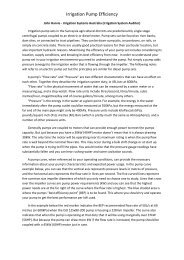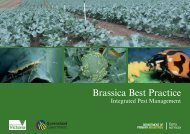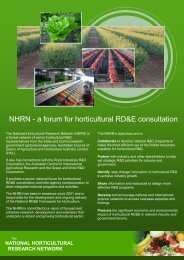National Horticultural Research Network - Horticulture Industry ...
National Horticultural Research Network - Horticulture Industry ...
National Horticultural Research Network - Horticulture Industry ...
You also want an ePaper? Increase the reach of your titles
YUMPU automatically turns print PDFs into web optimized ePapers that Google loves.
<strong>National</strong> <strong>Horticultural</strong> <strong>Research</strong> <strong>Network</strong><br />
Implementing the future Framework September 2010<br />
___________________________________________________________________<br />
industries benefit from adopting a strategic approach to industry development. This will be achieved<br />
by ensuring every member undertakes a HAL <strong>Industry</strong> Development Needs Assessment resulting in<br />
activities that are accountable and measurable and reflect rural industry best practice.<br />
The <strong>Industry</strong> Development Needs Assessment is a comprehensive nine step process to determine the<br />
best, most efficient way of delivering industry development within an industry. Each step has a series<br />
of guidelines and tools. The time needed and level of complexity of the assessment is largely<br />
determined by the size of the industry. Each industry, however, is required to ensure the participation<br />
of key industry members who, collectively, have a mix of industry knowledge, experience, strategic<br />
thinking and ability to provide different perspectives.<br />
Through this process individual industries will determine and tailor their own mix of industry<br />
development strategies in the areas of information, consultation, facilitation, training and technology<br />
adoption. An overarching goal is to have more across-industry initiatives and whole-of-value chain<br />
approaches while ensuring the ongoing professional development within industries through career and<br />
leadership development and maintaining science-based expertise.<br />
6.2.6 Role of the NHRN<br />
The NHRN will continue to play a central role in the proposed Framework. This role can be<br />
summarised as follows;<br />
Initiate reviews of the progress and effectiveness of the <strong>Horticulture</strong> RD&E Framework in<br />
deliver RD&E outcomes for the horticultural industries<br />
Respond to any gaps/weaknesses that emerge to ensure industry R,D&E needs continue to be<br />
adequately met. This includes initiating processes to account for changed future capabilities<br />
of PISC agencies.<br />
With the relevant industry peak bodies, oversee the progress and delivery of Coordinated<br />
<strong>National</strong> Programs (see 6.2.3 above).<br />
NHRN‟s existing roles, which are listed below, would continue. They include;<br />
Identify relevant and step change areas that are a priority for innovative horticultural research<br />
and development<br />
Work with HAL and other agencies with a horticulture focus (eg. GWRDC, RIRDC, and<br />
ACIAR) and their supporting industries in the prioritisation and development of projects that<br />
enable delivery and adoption of research<br />
Support the development of strategic plans for each of the areas of technical expertise<br />
relevant to the NHRN agencies<br />
Maintain and build Australia‟s combined RD&E capability and resources in horticulture.<br />
Continue development of shared international contacts for horticultural R&D and the<br />
development of staff<br />
Agree to co-invest in collaborative cross agency and cross industry projects by matching staff<br />
and resources to projects<br />
Extend services to R&D funding agencies for peer review of proposals<br />
Link and participate in network groups to maximise impact of RD&E.<br />
An example of the NHRN carrying out these roles is with the Mechanisation, Automation, Robotics<br />
and Remote Sensing (MARRS) project. Recognising that Australia‟s most competitive horticultural<br />
industries such as almonds, olive oil and wine grapes, rely largely on mechanisation to reduce<br />
production costs and so improve the value proposition Australia can offer (where value =<br />
quality/price), NHRN has worked with HAL to establish a major R&D program in the MARRS area<br />
for wider application across selected horticultural crops. The first stage of this, currently underway, is<br />
a scoping study to review the use of MARRS-type technologies with potential for horticulture,<br />
83 | P a g e






